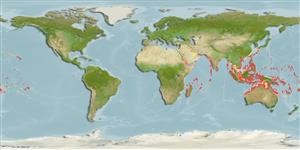>
Eupercaria/misc (Various families in series Eupercaria) >
Scaridae (Parrotfishes) > Scarinae
Etymology: Bolbometopon: Greek, bolbos-ou = onion + Greek, metopon = brow (Ref. 45335).
More on author: Valenciennes.
Environment: milieu / climate zone / depth range / distribution range
Ökologie
seewasser riff-verbunden; tiefenbereich 0 - 40 m (Ref. 90102). Tropical; 34°N - 26°S, 32°E - 145°W (Ref. 116632)
Indo-Pacific: Red Sea and East Africa to Samoa and the Line Islands, north to the Yaeyama and Wake islands, south to the Great Barrier Reef and New Caledonia.
Size / Gewicht / Alter
Maturity: Lm ? range ? - ? cm
Max length : 130 cm TL Männchen/unbestimmt; (Ref. 9710); common length : 70.0 cm SL Männchen/unbestimmt; (Ref. 9793); max. veröff. Gewicht: 46.0 kg (Ref. 2334)
Rückenflossenstacheln (insgesamt): 9; Rückenflossenweichstrahlen (insgesamt): 10; Afterflossenstacheln 3; Afterflossenweichstrahlen: 9. This species is distinguished by the following characters: median predorsal scales 2-4 (may be obscured by hump); 3 scale rows on cheek, 1 (4-6), 2 (3-6), 3 (1-2); pectoral-fin rays 16 or 17; steep profile distinctive; nodules on teeth unique (Ref. 9793); prominent bump on forehead of adult (evident at least 25 cm TL); deep body 2.0-2.5 in SL, with depth increasing with growth; Colour of juveniles brownish to green with 5 vertical rows of whitish spots on side, the primary phase is a dull gray with scattered white spots, gradually becoming uniformly dark green (Ref. 90102, 1602).
Juveniles are found in lagoons while adults inhabit clear outer lagoon and seaward reefs up to depths of at least 30 m (Ref. 9710). They ‘sleep’ in caves and often in shipwrecks at night (Ref. 48636). They are usually in small groups feeding on benthic algae, live corals (Ref. 9710) and shellfishes (Ref. 58784). They sometimes ram their head against corals to facilitate feeding (Ref. 9710). The largest and wariest of the parrotfishes. Assessments showed their vulnerability to overfishing (Ref. 9710). Minimum depth reported taken from Ref. 128797.
Life cycle and mating behavior
Geschlechtsreife | Fortpflanzung | Ablaichen | Eier | Fecundity | Larven
Oviparous, distinct pairing during breeding (Ref. 205). Also Ref. 103751.
Randall, J.E., G.R. Allen and R.C. Steene, 1990. Fishes of the Great Barrier Reef and Coral Sea. University of Hawaii Press, Honolulu, Hawaii. 506 p. (Ref. 2334)
IUCN Rote Liste Status (Ref. 130435)
Bedrohung für Menschen
Harmless
Nutzung durch Menschen
Fischereien: kommerziell; Aquarium: Kommerziell
Mehr Information
ReferenzenAquakulturAquakultur ProfilZuchtlinienGenetikElectrophoresesVererbbarkeitKrankheitenVerarbeitungNutrientsMass conversion
Tools
Zusatzinformationen
Download XML
Internet Quellen
Estimates based on models
Preferred temperature (Ref.
123201): 25.3 - 29.1, mean 28.2 °C (based on 2570 cells).
Phylogenetic diversity index (Ref.
82804): PD
50 = 1.0000 [Uniqueness, from 0.5 = low to 2.0 = high].
Bayesian length-weight: a=0.01380 (0.00641 - 0.02973), b=3.03 (2.86 - 3.20), in cm total length, based on LWR estimates for this (Sub)family-body shape (Ref.
93245).
Trophic level (Ref.
69278): 2.7 ±0.41 se; based on food items.
Generation time: 11.0 ( na - na) years. Estimated as median ln(3)/K based on 2
growth studies.
Widerstandsfähigkeit (Ref.
120179): niedrig, Verdopplung der Population dauert 4,5 - 14 Jahre. (K=0.10).
Fishing Vulnerability (Ref.
59153): High to very high vulnerability (67 of 100).
Climate Vulnerability (Ref.
125649): Very high vulnerability (92 of 100).
Nutrients (Ref.
124155): Calcium = 19 [11, 34] mg/100g; Iron = 0.448 [0.252, 0.800] mg/100g; Protein = 18.9 [16.8, 20.7] %; Omega3 = 0.0876 [, ] g/100g; Selenium = 43.7 [22.6, 76.4] μg/100g; VitaminA = 40.3 [12.6, 120.3] μg/100g; Zinc = 1.14 [0.81, 1.69] mg/100g (wet weight);
